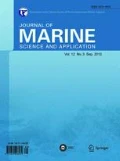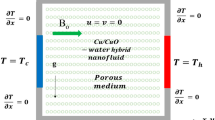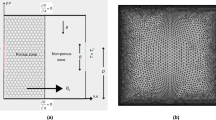Abstract
This paper introduces a new idea of controlling cavitation around a hydrofoil through a passive cavitation controller called artificial cavitation bubble generator (ACG). Cyclic processes, namely, growth and implosion of bubbles around an immersed body, are the main reasons for the destruction and erosion of the said body. This paper aims to create a condition in which the cavitation bubbles reach a steady-state situation and prevent the occurrence of the cyclic processes. For this purpose, the ACG is placed on the surface of an immersed body, in particular, the suction surface of a 2D hydrofoil. A simulation was performed with an implicit finite volume scheme based on a SIMPLE algorithm associated with the multiphase and cavitation model. The modified k-ε RNG turbulence model equipped with a modification of the turbulent viscosity was applied to overcome the turbulence closure problem. Numerical simulation of water flow over the hydrofoil equipped with the ACG shows that a low-pressure recirculation area is produced behind the ACG and artificially generates stationary cavitation bubbles. The location, shape, and size of this ACG are the crucial parameters in creating a proper control. Results show that the cavitation bubble is controlled well with a well-designed ACG.
Similar content being viewed by others
References
Alajbegovic A, Gorger HA, Philip H, 1999. Calculation of transient cavitation in nozzle using the two-fluid model. 12th Annual Conference on Liquid Atomization and Spray Systems, Indianapolis, USA.
ANSYS Fluent Theory Guide, Release 15.0, ANSYS, Inc. November, 2013.
ANSYS Fluent User's Guide. Release 15.0. ANSYS, Inc. November, 2013.
Brennen CE, 1995. Cavitation and bubble dynamics. Oxford University Press, New York.
Coutier-Delgosha O, Deniset F, Astolfi JA, Leroux JB, 2007. Numerical prediction of cavitating flow on a two-dimensional symmetrical hydrofoil and comparison to experiments. ASME Journal of Fluids Engineering, 129(3), 279–292. DOI: 10.1115/1.2427079
Coutier-Delgosha O, Fortes-Patella R, Reboud JL, 2003. Evaluation of turbulence model influence on the numerical simulations on unsteady cavitation. ASME Journal of Fluids Engineering, 125(1), 38–45. DOI: 10.1115/1.1524584
Dular M, Bachert R, Stoffel B, Širok B, 2005. Experimental evaluation of numerical simulation of cavitating flow around hydrofoil. European Journal of Mechanics-B/Fluids, 24, 522–538. DOI: 10.1016/j.euromechflu.2004.10.004
Franc JP, Michel JM, 2004. Fundamentals of cavitation. Kluwer Academic Publishers, New York, Boston, Dordrecht, London, Moscow.
Huang B, Young YL, Wang G, Shyy W, 2013. Combined experimental and computational investigation of unsteady structure of sheet/cloud cavitation. ASME Journal of Fluids Engineering, 135, 071301. DOI: 10.1115/1.4023650
Ji B, Luo XW, Arndt RE, Peng X, Wu Y, 2015. Large eddy simulation and theoretical investigations of the transient cavitating vortical flow structure around a NACA66 hydrofoil. International Journal of Multiphase Flow, 68, 121–134. DOI: 10.1016/j.ijmultiphaseflow.2014.10.008
Johansen S, Wu J, Shyy W, 2004. Filter-based unsteady RANS computations. International Journal of Heat and Fluid Flow, 25(1), 10–21. DOI: 10.1016/j.ijheatfluidflow.2003.10.005
Kerho MF, Kramer BR, 2003. Enhanced airfoil design incorporating boundary layer mixing devices. AIAA Paper 2003-0211, USA. DOI: 10.2514/6.2003-211
Kim SE, 2009. A Numerical study of unsteady cavitation on a hydrofoil. Proceedings of the 7th International Symposium on Cavitation, Michigan, USA, No. 56.
Kubota A, Hiroharu A, Yamaguchi H, 1992. A new modeling of cavitating flows-a numerical study of unsteady cavitation on a hydrofoil section. Journal of Fluid Mechanic, 240(1), 59–96. DOI: 10.1017/S002211209200003X
Li DQ, Grekula M, Lindell P, 2009. A modified SST k-? turbulence model to predict the steady and unsteady sheet cavitation on 2D and 3D hydrofoils. Proceedings of the 7th International Symposium on Cavitation, Michigan, USA, No. 107.
Liu DM, Liu SH, Wu YL, Xu HY, 2009. LES numerical simulation of cavitation bubble shedding on ALE 25 and ALE 15 Hydrofoils. Journal of Hydrodynamics, 21(6), 807–813. DOI: 10.1016/S1001-6058(08)60216-4
Lu NX, Bensow RE, Bark G, 2010. LES of unsteady cavitation on the delft twisted foil. Journal of Hydrodynamics, 22(5), 784–791. DOI: 10.1016/S1001-6058(10)60031-5
Mostafa NE, Karim M, Sarker MA, 2012. Numerical study of unsteady behavior of partial cavitation on two dimensional hydrofoils. Journal of Shipping and Ocean Engineering, 2, 10–17.
Reboud JL, Stutz B, Coutier O, 1998. Two-phase flow structure of cavitation: experiment and modelling of unsteady effects. Third International Symposium on Cavitation, Grenoble, France.
Seo JH, Lele SK, 2009. Numerical investigation of cloud cavitation and cavitation noise on a hydrofoil section. Proceedings of the 7th International Symposium on Cavitation, Michigan, USA.
Wu J, Utturkar Y, Shyy W, 2003. Assessment of modeling strategies for cavitating flow around a hydrofoil. Fifth International Symposium on Cavitation (Cav2003), Osaka, No. cav03-OS-1-7, 1-4.
Yang J, Zhou LJ, Wang ZW, 2011. Numerical simulation of three-dimensional cavitation around a hydrofoil. ASME Journal of Fluids Engineering, 133(8), 081310. DOI: 10.1115/1.4004385
Zhou L, Wang Z, 2008. Numerical simulation of cavitation around a hydrofoil and evaluation of a RNG k-e model. ASME Journal of Fluids Engineering, 130(1), 011302. DOI: 10.1115/1.2816009
Author information
Authors and Affiliations
Corresponding author
Rights and permissions
About this article
Cite this article
Javadi, K., Dorostkar, M.M. & Katal, A. Cavitation passive control on immersed bodies. J. Marine. Sci. Appl. 16, 33–41 (2017). https://doi.org/10.1007/s11804-017-1400-3
Received:
Accepted:
Published:
Issue Date:
DOI: https://doi.org/10.1007/s11804-017-1400-3




